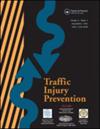调查基于替代措施的安全指数,用于预测信号灯控制交叉路口的伤害事故。
IF 1.6
3区 工程技术
Q3 PUBLIC, ENVIRONMENTAL & OCCUPATIONAL HEALTH
引用次数: 0
摘要
目标:本文开发了一种基于机器学习的安全指数,用于对交通冲突进行分类,该指数可用于估算信号灯路口碰撞事故的频率,重点关注导致死亡和重伤的较严重碰撞事故。根据安全指数分类的不同严重程度的冲突数量被用作一个解释变量,用于开发主动估计碰撞事故的统计模型:方法:使用自动编码器神经网络整合方法,通过频率和严重程度指标的联合整合,确定左转车辆和对向通过车辆之间不同严重程度的冲突(这是信号灯路口公认的严重伤害碰撞类型),从而得出异常分数。然后建立回归模型,根据安全指数值将同一交叉口的碰撞事故与分类冲突联系起来。对累积残差图进行了研究。最后,制定了定义连续异常等级之间界限的方程,以方便实际应用:结果:利用基于异常得分的极端冲突分类建立的总碰撞和致命加严重(FSI)碰撞回归模型优于使用总碰撞的模型。对 FSI 碰撞的改进更为明显。结果还表明,机器学习集成方法可以有效地根据碰撞严重程度对冲突进行准确分类,因为较高的异常分数与较高的碰撞严重程度(即 FSI)相关:所提出的框架代表了基于交通冲突的撞车估算方法的进步,它使用机器学习模型根据异常分数对冲突进行分类。对于没有资源为自己的数据集开发此类冲突分类模型的辖区来说,可以使用定义连续异常分数级别之间界限的简单方程作为近似值。本文章由计算机程序翻译,如有差异,请以英文原文为准。
Investigation of a surrogate measure-based safety index for predicting injury crashes at signalized intersections
Objectives
The paper develops a machine learning-based safety index for classifying traffic conflicts that can be used to estimate the frequency of signalized intersection crashes, with a focus on the more severe ones that result in fatal and severe injury. The number of conflicts in different severity levels categorized by the safety index is used as an explanatory variable for developing statistical models for pro-actively estimating crashes.
Methods
Video-derived conflicts in different severity levels between left-turning vehicles and opposing through vehicles, a well-recognized severe injury crash typology at signalized intersections, were identified by jointly integrating the indicators of frequency and severity, using an autoencoder neural network integration method to develop anomaly scores. Regression models were then developed to relate crashes at the same intersections to the classified conflicts based on the value of their safety indexes. Cumulative Residual plots were investigated. Finally, equations defining the boundary between consecutive anomaly score levels were developed to facilitate application in practice.
Results
Regression models for total and fatal plus severe (FSI) crashes utilizing classified extreme conflicts based on anomaly scores were found to outperform the models using total conflicts. The improvement is more pronounced for FSI crashes. The results also suggest that the machine learning integration method can efficiently classify conflicts accurately according to crash severity levels since the higher anomaly score is associated with a higher crash severity level (i.e., FSI).
Conclusions
The proposed framework represents a methodological advancement in traffic conflict-based estimation of crashes using a machine learning model to classify conflicts by their anomaly scores. For jurisdictions without the resources to develop such a model to classify conflicts for their own datasets, the simple equations defining the boundary between consecutive anomaly score levels could be used as an approximation.
求助全文
通过发布文献求助,成功后即可免费获取论文全文。
去求助
来源期刊

Traffic Injury Prevention
PUBLIC, ENVIRONMENTAL & OCCUPATIONAL HEALTH-
CiteScore
3.60
自引率
10.00%
发文量
137
审稿时长
3 months
期刊介绍:
The purpose of Traffic Injury Prevention is to bridge the disciplines of medicine, engineering, public health and traffic safety in order to foster the science of traffic injury prevention. The archival journal focuses on research, interventions and evaluations within the areas of traffic safety, crash causation, injury prevention and treatment.
General topics within the journal''s scope are driver behavior, road infrastructure, emerging crash avoidance technologies, crash and injury epidemiology, alcohol and drugs, impact injury biomechanics, vehicle crashworthiness, occupant restraints, pedestrian safety, evaluation of interventions, economic consequences and emergency and clinical care with specific application to traffic injury prevention. The journal includes full length papers, review articles, case studies, brief technical notes and commentaries.
 求助内容:
求助内容: 应助结果提醒方式:
应助结果提醒方式:


